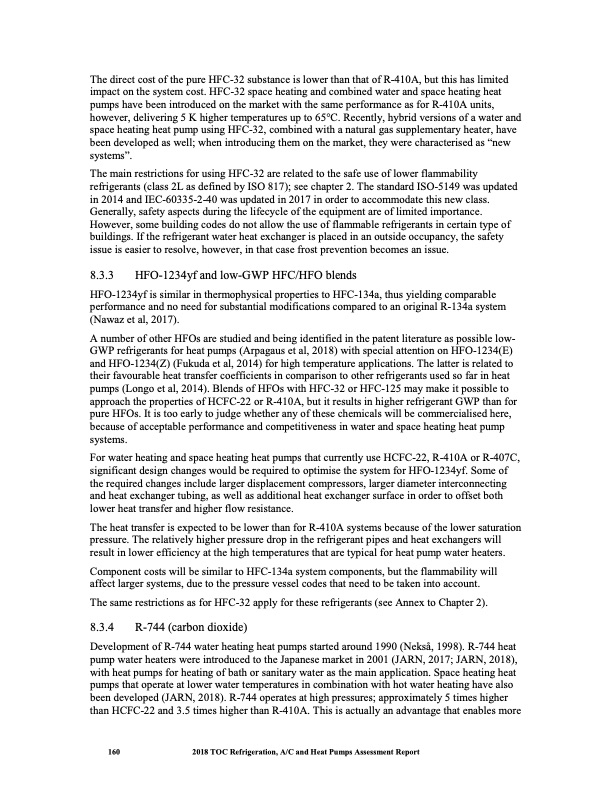
PDF Publication Title:
Text from PDF Page: 173
The direct cost of the pure HFC-32 substance is lower than that of R-410A, but this has limited impact on the system cost. HFC-32 space heating and combined water and space heating heat pumps have been introduced on the market with the same performance as for R-410A units, however, delivering 5 K higher temperatures up to 65°C. Recently, hybrid versions of a water and space heating heat pump using HFC-32, combined with a natural gas supplementary heater, have been developed as well; when introducing them on the market, they were characterised as “new systems”. The main restrictions for using HFC-32 are related to the safe use of lower flammability refrigerants (class 2L as defined by ISO 817); see chapter 2. The standard ISO-5149 was updated in 2014 and IEC-60335-2-40 was updated in 2017 in order to accommodate this new class. Generally, safety aspects during the lifecycle of the equipment are of limited importance. However, some building codes do not allow the use of flammable refrigerants in certain type of buildings. If the refrigerant water heat exchanger is placed in an outside occupancy, the safety issue is easier to resolve, however, in that case frost prevention becomes an issue. 8.3.3 HFO-1234yf and low-GWP HFC/HFO blends HFO-1234yf is similar in thermophysical properties to HFC-134a, thus yielding comparable performance and no need for substantial modifications compared to an original R-134a system (Nawaz et al, 2017). A number of other HFOs are studied and being identified in the patent literature as possible low- GWP refrigerants for heat pumps (Arpagaus et al, 2018) with special attention on HFO-1234(E) and HFO-1234(Z) (Fukuda et al, 2014) for high temperature applications. The latter is related to their favourable heat transfer coefficients in comparison to other refrigerants used so far in heat pumps (Longo et al, 2014). Blends of HFOs with HFC-32 or HFC-125 may make it possible to approach the properties of HCFC-22 or R-410A, but it results in higher refrigerant GWP than for pure HFOs. It is too early to judge whether any of these chemicals will be commercialised here, because of acceptable performance and competitiveness in water and space heating heat pump systems. For water heating and space heating heat pumps that currently use HCFC-22, R-410A or R-407C, significant design changes would be required to optimise the system for HFO-1234yf. Some of the required changes include larger displacement compressors, larger diameter interconnecting and heat exchanger tubing, as well as additional heat exchanger surface in order to offset both lower heat transfer and higher flow resistance. The heat transfer is expected to be lower than for R-410A systems because of the lower saturation pressure. The relatively higher pressure drop in the refrigerant pipes and heat exchangers will result in lower efficiency at the high temperatures that are typical for heat pump water heaters. Component costs will be similar to HFC-134a system components, but the flammability will affect larger systems, due to the pressure vessel codes that need to be taken into account. The same restrictions as for HFC-32 apply for these refrigerants (see Annex to Chapter 2). 8.3.4 R-744 (carbon dioxide) Development of R-744 water heating heat pumps started around 1990 (Nekså, 1998). R-744 heat pump water heaters were introduced to the Japanese market in 2001 (JARN, 2017; JARN, 2018), with heat pumps for heating of bath or sanitary water as the main application. Space heating heat pumps that operate at lower water temperatures in combination with hot water heating have also been developed (JARN, 2018). R-744 operates at high pressures; approximately 5 times higher than HCFC-22 and 3.5 times higher than R-410A. This is actually an advantage that enables more 160 2018 TOC Refrigeration, A/C and Heat Pumps Assessment ReportPDF Image | Heat Pumps Technical Options

PDF Search Title:
Heat Pumps Technical OptionsOriginal File Name Searched:
RTOC-assessment-report-2018_0.pdfDIY PDF Search: Google It | Yahoo | Bing
CO2 Organic Rankine Cycle Experimenter Platform The supercritical CO2 phase change system is both a heat pump and organic rankine cycle which can be used for those purposes and as a supercritical extractor for advanced subcritical and supercritical extraction technology. Uses include producing nanoparticles, precious metal CO2 extraction, lithium battery recycling, and other applications... More Info
Heat Pumps CO2 ORC Heat Pump System Platform More Info
| CONTACT TEL: 608-238-6001 Email: greg@infinityturbine.com | RSS | AMP |